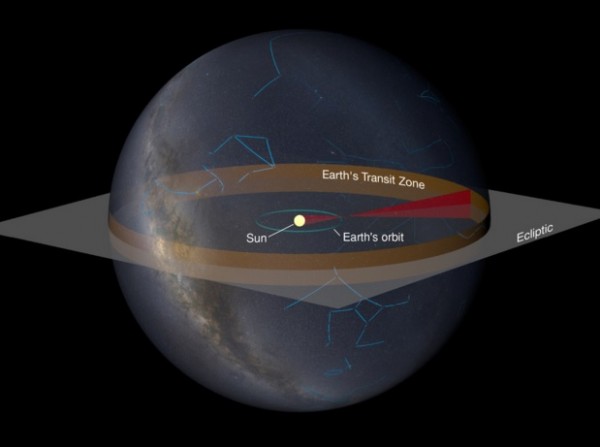By Ana Verayo, | March 02, 2016

Narrow band: the image illustrates the transit zone, in which distant observers could see the Earth pass in front of the Sun.
In order to answer the eternal question, "Are we alone in the universe?", astronomers have been devising a myriad of techniques in the past decades in order to search for habitable exoplanets and also signals from intelligent alien life.
The search for habitable planets outside our solar system has been successful, where more than 2,000 planets have been detected in distant stellar systems. However, looking for alien signals or SETI (Search for Extraterrestrial Intelligence) has not been successful so far.
Like Us on Facebook
According to researchers from the Max Planck Institute for Solar System Research, Germany and McMaster University in Canada, this search strategy has not realized its full potential until now, suggesting that future searches should be able to focus only on a specific part of the sky where alien observers from distant systems are able notice when Earth transits in front of the sun.
Those observers from this zone are able to detect Earth using the same methods that are used by human astronomers to discover and describe distant exoplanets. Researchers also believe that the chances of extraterrestrials to locate Earth are high, as they could already be sending signals in this higher region in the skies.
Using this strategy, astronomers can now narrow down their search to about 1/2000 of the sky, that can dramatically reduce the amount of data needed to be examined and analyzed.
This method is known as transient dimming, when a planet passes its host star, causing light to be blocked or to dim, as it travels to the direction of observatories on the surface of Earth. This transit can be measurable, depending on the size of the planet and the sensitivity of the telescope viewing it.
To date, majority of exoplanets have been detected using this transit method, where a similar technique known as transit spectroscopy, can enable astronomers to scan the atmosphere of gas planets, for any indications of life.
Researchers were able to identify a region in the sky that one can observe transits in less than half a solar radius from the center of the solar disk. This means that all potential exoplanetary systems can be perceived from this specific area in the sky, as the Earth's projected orbit around the sun is ecliptic from the celestial sphere. This area strip in the sky is also only 1/2000 of the entire sky.
According to René Heller from the Max Planck Institute for Solar System Research, the key point of this method is confining the search area to a very small portion of the sky. This would mean, there will be less than a human life span to search for potential extraterrestrial astronomers that have already discovered Earth, and who could have probably started contact.
Researchers already have a list of 82 nearby Sun like star systems that are immediate search targets for SETI searches.
-
Use of Coronavirus Pandemic Drones Raises Privacy Concerns: Drones Spread Fear, Local Officials Say

-
Coronavirus Hampers The Delivery Of Lockheed Martin F-35 Stealth Fighters For 2020

-
Instagram Speeds Up Plans to Add Account Memorialization Feature Due to COVID-19 Deaths

-
NASA: Perseverance Plans to Bring 'Mars Rock' to Earth in 2031

-
600 Dead And 3,000 In The Hospital as Iranians Believed Drinking High-Concentrations of Alcohol Can Cure The Coronavirus

-
600 Dead And 3,000 In The Hospital as Iranians Believed Drinking High-Concentrations of Alcohol Can Cure The Coronavirus

-
COVID-19: Doctors, Nurses Use Virtual Reality to Learn New Skills in Treating Coronavirus Patients







